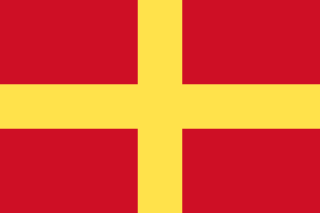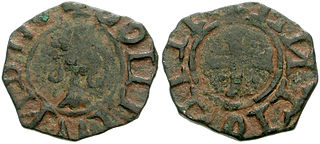
Bartholomew Mansel was the vicar of the diocese of Antioch, regent of Tripoli, and bishop of Tortosa around 1272, a post he held until 1291.

Bartholomew Mansel was the vicar of the diocese of Antioch, regent of Tripoli, and bishop of Tortosa around 1272, a post he held until 1291.
Bartholomew belonged to the important Frankish family of the Mansels in Antioch. [1] He was probably the son of Robert Mansel, who was Constable of Antioch in 1207. Simon Mansel, Constable of Antioch, was probably his brother. He was maternally related to King Hethum I, as his father married his half-sister.
In 1268, Bartholomew escaped the sack of Antioch, which was under the command of his brother Simon. He was appointed bishop of Tortosa when that see fell vacant in 1272. After the death of Bohemond VI in 1275, his widow, Sibylla, invited Bishop Bartholomew to act as regent for her young son, Bohemond VII. Since Bartholomew was also the vicar of the absentee patriarch of Antioch, Opizo dei Fieschi, this brought him into conflict with the bishop of Tripoli Paul of Segni. [2]
After he took up residence in Tripoli, Bartholomew, who outranked Paul both spiritually and secularly, sided with Paul's detractors among the native baronage. He also had a dispute with the Lord Guy II of Gibelet, which was provoked by the marriage of the heiress of Hugh l'Aleman to Guy's brother John, which preempted her marriage to Bartholomew's nephew.
Bartholomew, acting as patriarchal vicar, absolved Bohemond of the excommunication issued by Pope Nicholas III, following a letter from Paul to the Pope in which he accused Bohemond of seizing his goods, imprisoning his servants and attacking his safehouse.
He returned to Tortosa after the fall of Tripoli in 1289. On 3 August 1291, the Knight Templars and Bartholomew evacuated Tortosa, which had ceased to be a residential bishopric afterwards. [3]

The County of Tripoli (1102–1289) was the last of the Crusader states. It was founded in the Levant in the modern-day region of Tripoli, northern Lebanon and parts of western Syria. When the Frankish Crusaders – mostly southern French forces – captured the region in 1109, Bertrand of Toulouse became the first count of Tripoli as a vassal of King Baldwin I of Jerusalem. From that time, the rule of the county was decided not strictly by inheritance but by factors such as military force, favour and negotiation. In 1289 the County of Tripoli fell to Sultan Qalawun of the Muslim Mamluks of Cairo. The county was absorbed into Mamluk Egypt.

Bohemond III of Antioch, also known as Bohemond the Child or the Stammerer, was Prince of Antioch from 1163 to 1201. He was the elder son of Constance of Antioch and her first husband, Raymond of Poitiers. Bohemond ascended to the throne after the Antiochene noblemen dethroned his mother with the assistance of the lord of Armenian Cilicia, Thoros II. He fell into captivity in the Battle of Harim in 1164, but the victorious Nur ad-Din, atabeg of Aleppo released him to avoid coming into conflict with the Byzantine Empire. Bohemond went to Constantinople to pay homage to Manuel I Komnenos, who persuaded him to install a Greek Orthodox patriarch in Antioch. The Latin patriarch of Antioch, Aimery of Limoges, placed Antioch under interdict. Bohemond restored Aimery only after the Greek patriarch died during an earthquake in 1170.

Bohemond IV of Antioch, also known as Bohemond the One-Eyed, was Count of Tripoli from 1187 to 1233, and Prince of Antioch from 1201 to 1216 and from 1219 to 1233. He was the younger son of Bohemond III of Antioch. The dying Raymond III of Tripoli offered his county to Bohemond's elder brother, Raymond, but their father sent Bohemond to Tripoli in late 1187. Saladin, the Ayyubid sultan of Egypt and Syria, conquered the county, save for the capital and two fortresses, in summer 1188.
Bohemond VI, also known as the Fair, was the prince of Antioch and count of Tripoli from 1251 until his death. He ruled while Antioch was caught between the warring Mongol Empire and Mamluk Sultanate. He allied with the Mongols against the Muslim Mamluks and his Crusaders fought alongside the Mongols in their battles against the Mamluks. The Mamluks would achieve a historic victory against the Mongols and halt their advance westwards at the Battle of Ain Jalut. In 1268 Antioch was captured by the Mamluks under Baybars, and he was thenceforth a prince in exile. He was succeeded by his son, Bohemond VII.

Bohemond VII was the count of Tripoli and nominal prince of Antioch from 1275 to his death. The only part left of the Principality of Antioch was the port of Latakia. He spent much of his reign at war with the Templars (1277–1282).
Amalric, Lord of Tyre, also called Amalric of Lusignan or Amaury de Lusignan was a prince and statesman of the House of Lusignan, a younger son of King Hugh III of Cyprus and Isabella of the House of Ibelin. He was given the title of Lord of Tyre in 1291, shortly before the city of Tyre fell to the Mamluks of Egypt. He is often but incorrectly called the Prince of Tyre.
The Principality of Antioch mirrored the Latin Kingdom of Jerusalem in its selection of great offices: constable, marshal, seneschal, admiral, Chamberlain, butler, chancellor and at certain times also bailiff.

The Ramnulfids, or the House of Poitiers, were a French dynasty of Frankish origin ruling the County of Poitou and Duchy of Aquitaine in the 9th through 12th centuries. Their power base shifted from Toulouse to Poitou. In the early 10th century, they contested the dominance of northern Aquitaine and the ducal title to the whole with the House of Auvergne. In 1032, they inherited the Duchy of Gascony, thus uniting it with Aquitaine. By the end of the 11th century, they were the dominant power in the southwestern third of France. The founder of the family was Ramnulf I, who became count in 835.
Sibylla of Armenia was the princess of Antioch and countess of Tripoli by marriage to Bohemond VI from 1254 to 1275, and then regent of the County of Tripoli until their son, Bohemond VII, came of age in 1277. She was closely allied with the bishop of Tortosa, Bartholomew Mansel, which frustrated the scheme to install her as ruler of Tripoli instead of her daughter Lucia after Bohemond VII's death in 1287. During her lifetime, both the principality and the county were lost to the Egyptian Mamluks.

The Fall of Tripoli was the capture and destruction of the Crusader state, the County of Tripoli, by the Muslim Mamluks. The battle occurred in 1289 and was an important event in the Crusades, as it marked the capture of one of the few remaining major possessions of the Crusaders. The event is represented in a rare surviving illustration from a now fragmentary manuscript known as the 'Cocharelli Codex', thought to have been created in Genoa in the 1330s. The image shows the countess Lucia, Countess of Tripoli and Bartholomew, Bishop of Tortosa sitting in state in the centre of the fortified city, and Qalawun's assault in 1289, with his army depicted massacring the inhabitants fleeing to boats in the harbour and to the nearby island of St Thomas.

Aimery or Aymery of Limoges, also Aimericus in Latin, Aimerikos in Greek and Hemri in Armenian, was a Roman Catholic ecclesiarch in Frankish Outremer and the fourth Latin Patriarch of Antioch from c. 1140 until his death. Throughout his lengthy episcopate he was the most powerful figure in the Principality of Antioch after the princes, and often entered into conflict with them. He was also one of the most notable intellectuals to rise in the Latin East.
Opizzo Fieschi, also known as Opizo or Opiso dei' Fieschi, was a 13th-century Italian cleric from the powerful Genovese Fieschi family. Following his uncle Sinibaldo's election as Pope Innocent IV, Opizzo was appointed the Catholic Church's patriarch of Antioch.
The Roman Catholic Archdiocese of Tyre was an archbishopric in the Kingdom of Jerusalem.
The Latin Diocese of Tripoli was established in 1104 in the aftermath of the First Crusade. It remained a residential bishopric until 1289, after which it became a titular bishopric, which it remains today in the Catholic Church.
John was the chancellor of the Principality of Antioch from 1177 until 1183 and the bishop of Tripoli from 1183 until 1184. He was the archdeacon of the Patriarchate of Antioch during his time as chancellor before he became bishop. His appointment to the bishopric may have been intended as a reward for his years of service, but it may also indicate that he did not wish to serve Prince Bohemond III after the latter's conflict with Patriarch Aimery of Limoges. John briefly held the chancellorship and bishopric simultaneously—signing a charter of Bohemond III in May 1183—but soon relinquished it. He was succeeded as chancellor by Archbishop Albert of Tarsus, who was in office by 1184. He was succeeded as bishop by Aimery by 1186 at the latest.
Paul of Segni was an Italian nobleman and Franciscan friar who served as the bishop of Tripoli in the Levant from 1261 until 1285 and as a papal legate to the kingdoms of Germany and Sicily in 1279–1280. He was the most prominent churchman from the east at the Second Council of Lyon in 1274. After 1275, he was involved in a dispute with the bishop of Tortosa that took him to Rome. He spent his last five years in Italy.
Latin Diocese of Tortosa in Syria was a Roman Catholic diocese established in the Syrian city of Tartus after the First Crusade. It had a resident bishop between 1128 and 1291. The cathedral of Tortosa became the site of a Marian shrine.
Guy II or Guido II, surnamed Embriaco, was the lord of Gibelet from about 1271 until his death.

The fall of Outremer describes the history of the Kingdom of Jerusalem from the end of the last European Crusade to the Holy Land in 1272 until the final loss in 1302. The kingdom was the center of Outremer—the four Crusader states—formed after the First Crusade in 1099 and reached its peak in 1187. The loss of Jerusalem in that year began the century-long decline. The years 1272–1302 are fraught with many conflicts throughout the Levant as well as the Mediterranean and Western European regions, and many Crusades were proposed to free the Holy Land from Mamluk control. The major players fighting the Muslims included the kings of England and France, the kingdoms of Cyprus and Sicily, the three Military Orders and Mongol Ilkhanate. Traditionally, the end of Western European presence in the Holy Land is identified as their defeat at the Siege of Acre in 1291, but the Christian forces managed to hold on to the small island fortress of Ruad until 1302.
Simon Mansel was a Constable of Antioch.